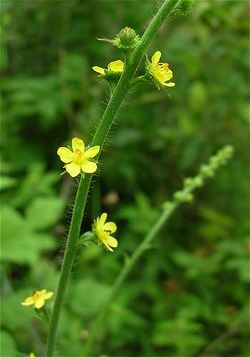Agrimonia gryposepala
From Wikiwel
Other Names : tall hairy agrimony, common agrimony, hooked agrimony, tall hairy grooveburr
a small perennial flowering plant of the rose family (Rosaceae), which is native to North America.
Special Precautions of Agrimonia gryposepala
Health Benefits and Uses of Agrimonia gryposepala
Across North America, various indigenous peoples used the plant for medicinal purposes.
- Among the Iroquois people, a drink made from the roots of the plant was used for diarrhea.
- Among the Cherokee, the plant was used for the same purpose, to reduce fever, and for a range of other problems.
- The Ojibwe used the plant for urinary problems,
- The Meskwaki and Prairie Potawatomi used it as a styptic for nosebleeds.
These ethnobotanical uses of the plant have some similarities to the traditional medical uses of Agrimonia eupatoria, which is native to Europe, Asia, and Africa.
- Agrimony’s astringency is effective against diarrhea, especially in small children, and because of its low toxicity, the herb is particularly suitable for children’s illnesses.
- Agrimony stops irritation of the urinary tract that may increase a child’s urge to urinate and, therefore, may be useful in the treatment of bladder leakage (cannot hold urine), bed-wetting and adult incontinence.
- Agrimony is perhaps best known as a wound herb used on medieval battlefields to staunch bleeding. This same property helps to staunch heavy menstrual bleeding as well. Agrimony is most used in modern herbal practice as a mild astringent and a tonic
- The tannins it contains tone the mucus membranes making it is useful for alleviating the symptoms of coughs and sore throats.
- The combination of being a bitter tonic as well as an astringent herb make agrimony a valuable tonic for the digestive system and a useful remedy for healing peptic ulcers.
- The bitter principles in the plant support the function of the liver and gallbladder.
- The herbal tea can be used as a skin wash; it is thought to improve minor injuries and chronic skin conditions.
References
* "Plants Profile for Agrimonia gryposepala (tall hairy agrimony )". plants.usda.gov. Retrieved 22 January 2018. * James W. Herrick and Dean R. Snow (1997). Iroquois Medical Botany. Syracuse University Press. p. 161. ISBN 0-8156-0464-5.
- Daniel E. Moerman (2009). Native American Medicinal Plants: An Ethnobotanical Dictionary. Timber Press. pp. 52–53. ISBN 0-88192-987-5.
